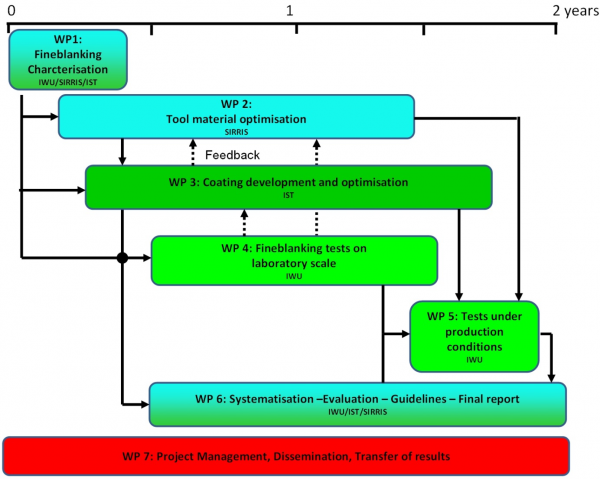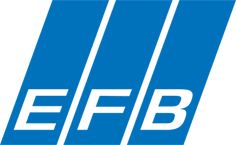Objectives and research methods of the INFIBLANK Project
This project has the following objectives:
- The increase of the general lifetime of tools for cutting and blanking operations, by means of special coatings in combination with a substrate that possesses optimal hardness and toughness.
- The application of these coatings so that the tool is covered with a uniform and good adhesive layer
- The selection of PVD coatings and steel substrates for cutting and blanking of high strength steel and stainless steel
- The possibility to use DLC based coatings as well as self adapting coatings to achieve the goal
- The study of combined heat and deep cryogenic treatment (DCT) to obtain a stable wear resistant structure for the tool substrate so that no distortion occurs after the coating operation and wear is substantially reduced after cutting operation.
- The possibility to work with or without lubrication and to obtain a high service lifetime
The research methods which will be used are:
- Theoretical studies
- Lab scale tests for initial determination of optimized coating/substrate combinations
- Heavy duty industrial tests for concept prove of optimized combinations
Theoretical studies
All relevant data concerning the base material treatment, the coating characterization and the fine blanking technology will be gathered. The limiting factors and the failure modes will be identified. Design measures for coating/substrate combinations will be investigated which lead for example to a better efficiency, a smaller tool wear and a higher tool lifetime.
Lab scale tests
Based on initial tests of substrate/coating specimen the investigation on optimized combinations will be done. Afterwards the best combinations will be tested in real tool application on lab scale base in a general tool for small fine blanking components. The experimental work will be performed using the equipment of IWU (press). The experimental research on lab scale will focus on basic hole or triangle geometries.
Heavy duty industrial tests
The optimized Coating/Substrate combination will be tested in two complex demonstrator geometries. (one demonstrator in each Country / Region). The work pieces to be manufactured will be real production parts (within the limits of the possibilities, based on the size, complexity, and so on).
The obtained cut sheet materials and the tools can be investigated using the following techniques:
- visual inspection
- 3D-geometrical measurements
- Metallographic investigations for quality measures
- SEM-micrograph inspection
Work Packages in the INFIBLANK project

Work package 1: Characterization of the fine-blanking process.
In this part the work conditions and specifications for fine blanking different materials will be collected. The results will be used for the next WP's.
Work package 2: Optimization of the tool material.
As explained above the material selection and the subsequent heat/cold treatment of these materials is of upmost importance for the success of the final coating operation. In this part several tool materials used in industrial environment will be listed from WP1 and a well defined selection will be made for the best coating development in WP 3.
Also new developed steel materials will be involved in this selection. The selected materials will be subjected to a combined heat and cold treatment to enhance hardness, toughness and stability. Finally characterization of the mechanical and structural properties will be performed.
In combination the coating development and the well defined selection of steel materials will be made for the laboratory tests. From the results obtained in WP3 and WP4 feedback will be given to optimize the substrate by adapting the heat or cold treatment.
Work package 3: Coating development for fine blanking tools.
The coating development starts with the coating of reference samples and the determination of the coating properties on it. In iterative loops the coating properties shall be optimized. In the next step test and production tools will be coated with the best coating procedures. After cutting tests in WP 4 and WP 5 a detailed wear analysis will give information for further coating optimization.
Work package 4: Cutting tests on a laboratory scale
The cutting test on laboratory scale will be done on a fine blanking tool already available at Fraunhofer IWU where several test geometries exist. One test geometry will be chosen, that allows the determination of tool wear and component quality under relatively short production cycles.
The test will be done in a conventional press at Fraunhofer IWU. As results the tool analysis and the component quality measurements will be delivered to all project partners for a detailed evaluation of the best coating and tool material combinations for the fine blanking application.
Work package 5: Cutting tests under production conditions
To verify the practical tests on a laboratory scale, the coated tool and active parts for a demonstrator will be used at a supporting SME in each country for application trials under production conditions. Therefore the demonstrator tool will be manufactured, heat treated and coated. After the tests the tool analysis and the component quality measurements will be delivered to all project partners.
Work package 6: Evaluation and systematization of the experimental results, final report
The results of the above mentioned cutting tests in WP4 and WP 5 will be compared and evaluated in order to determine the performance of the examined combination of substrate and coating for fine blanking. In the end the final report will be written by all partners.
Work package 7: Transfer of the results to the industry.
This part will provide professional feed-back between the partners and users as well as the dissemination of the results within the user group

